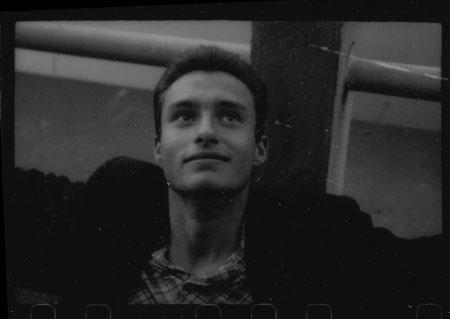Looking for…
Looking for…
Wij creërden voor de bezoekers een ervaring die hen liet kennismaken met onze specifieke manier van kijken én met die van de bezoeker zelf.
Belangrijke inspiratiebron voor Looking for… vormden een doos fotorolletjes die Lena vond in Praag tijdens de PQ in 2003. De rolletjes werden ontwikkeld. Het waren foto’s uit de jaren ’60, genomen in Praag en omstreken, soms geënsceneerd, soms met een theatrale inslag. Deze foto’s vormden de basis van het project en waren het uitgangspunt bij gesprekken over kijken, over het creëren van theatrale beelden. Wij spraken over ons werk, probeerden te verwoorden wat ons raakte. We zochten naar de betekenis van de foto’s en letterlijk naar de fotograaf die ze had genomen. We hingen posters op in Praag, met afgebeeld de jongen waarvan we dachten dat het de fotograaf was.

Zo ontstond ‘Looking for…’ een zoektocht naar onze manier van kijken en die van de
bezoeker. Een aantal locaties op de foto’s konden we herleiden. Deze bevonden zich in de buurt van het museum waar de PQ 2011 werd gehouden. We stelden een route samen langs de plekken waar de originele foto’s gemaakt waren. De toeschouwer kon de route lopen met behulp van een mobiele telefoon, die geleend kon worden bij Nederlandse paviljoen. Op deze telefoon was het programma 7scenes (ontworpen door de Waag Society) geïnstalleerd. Ook konden bezoekers op hun eigen smartphone dit programma downloaden. Aan de voorkant van het paviljoen werden de originele fotorolletjes tentoongesteld en konden mensen op een scherm volgen welke routes er op dat moment gelopen werden.
Het programma – 7scenes – maakt het mogelijk om via het GPS-signaal de route te volgen waarop op de door ons aangegeven locaties een foto verscheen en/of audio te horen viel. De foto’s (door ons gemaakt) stuurden de toeschouwer in zijn kijken. De te beluisteren teksten gaven een weerslag van onze gesprekken, onze fantasie bij het zien van de foto’s in combinatie met historische informatie. De originele foto’s werden dus theatraal besproken, maar pas aan het einde van de route, terug in het Nederlandse paviljoen getoond.
Via opdrachten spoorden we de bezoeker aan zelf foto’s te nemen, naar aanleiding van de teksten die ze net gehoord hadden. Deze foto’s werden tijdens het wandelen uitgeprint in het paviljoen. Bij terugkomst konden ze hun eigen foto’s ophangen naast de originele foto’s. Altijd was één ons aanwezig om gesprekken en discussies aan te gaan met de toeschouwers over overeenkomsten en verschillen in ‘kijken’. Het Nederlandse palviljoen dat we onwierpen, was bij aanvang van de PQ een lege witte met enkel de originele zwartwit foto’s. Gedurende de PQ werd die doos door bezoekers gevuld met hún beelden, hún manier van kijken en hún uitsnedes van de werkelijkheid.
Tekst Marloeke van de Vlugt en Roos van Geffen
De tekst die de toeschouwers hoorden en lazen op hun smartphone:
LOCATION 1
Hello
We are four designers from the Netherlands.
Lena Müller, Theun Mosk, Marloeke van der Vlugt and Roos van Geffen.
For our contribution to the Prague Quadrennial, we used the black and white photographs Lena found, to guide us.
A path was formed.
Let us accompany you on this route through a strange city.
We’ll share our thoughts about the found pictures and
about our personal way of looking.
This is not a sightseeing tour.
We created our own visual map to help you find the route.
Through locating the photos you’ll be guided to the specific locations.
Use your phone to search, to watch, to listen and to take pictures.
We will provide the frame.
Assignment as text on screen:
Please walk to the right into Dukel. hrdinu.
LOCATION 2: Bench at Tramstop overlooking the butcher
Do you see the tramstop at the left of the street?
There is a bench,
please sit down for a moment
(Break of 10 sec)
…….
………
………….
…
….
Waiting for a tram
you can’t influence its arrival
if you accept this
it creates time in between
this is not waiting
……
…….
Less than 50 years ago a young woman was photographed
brown short, neatly cut hair, decent skirt on the knee.
she was sitting at the edge, on the extreme corner of the bench
Her legs a bit stretched, her arms crossed,
her hands in her lap
she sits as she is expected to sit
how she has been raised
nicely, according to the rules of decency
she looks uncomfortable
she waits until the photographer nodds
she smiles shyly
Click (audio)
Waiting for the bus, feeling unnoticed
or consciously waiting for a photo to be taken
theatre exists in between watching and being watched
take a picture here
Assignment as text on screen:
take a picture here
LOCATION 3: theatre in the grass
Audio:
Please walk to the little bloom garden
Keep the little water pool at your left
Here a thought for you to ponder on:
If a tree were to fall on a deserted island,
would there be any sound?
….
Or in other words:
Something only exists if it is perceived.
But when it is perceived its state of being changes.
When does something become theatrical?
The photographer probably thought:
This time I want to make a ‘happy’ photo
Casually taken
the bright side of life
A free impression
In the grass
By putting these thoughts in words
The women became characters,
they became so self conscious
Skirts were pulled down
Although they wanted to present lightness the result looked stiff and heavy
Cheering in a frozen state
Is it possible to stage real happiness?
Make a happy photo of the stage in front of you
Assignment as text on screen:
Please walk to the little bloom garden
Keep the water pool at your left
After you listened to the audio-file,
Make a happy photo of the stage in front of you
LOCATION 4: in front of EXPO 58
AUDIO
A glass building with a glossy history
A famous pavilion that was placed in Prague
right after it was exhibited at the EXPO 58, Brussels World’s Exhibition.
Here Svoboda experimented with theater and film.
At the opening, chic and elegant people slowly filled the terrace.
cups of tea, glasses of wine, soft murmuring
A real film location.
The photographer tried to capture the ambiance
To create a tight combination of imagination and reality,
caught in an instant.
Before making this photo he had to make many decisions
Focus, depth, distance, shutter speed, sharpness, lighting
Filtering down, coming to the essence
Now, imagine: every photo you take erases a piece of reality.
Click: one cloud less.
Click: a window gone.
Click: a body vanished.
What is the image you would keep?
Take this picture
Assignment on screen: What is the image you would keep?
Take this picture.
LOCATION 5: Girl with flower above water
It’s 17.43 in the afternoon
Almost time to go for a big extensive dinner
It’s been a very warm day
He wants to make the perfect holiday picture
’postcard quality’
She has deliberately put on something pretty
She looks seductive,
wearing a blonde wig
Flower in her hair
Feather brooch on her neat suit
The suit with the bright shiny mother of pearl buttons
She carries a small handbag
The hands on top of each other
neatly
but loose,
hanging hands
this time
This woman is not posing for the first time.
She has done this before
Let ‘ s try to locate the exact position of the photographer,
Let us direct your gaze
The girl is standing in front of the bushes,
Back towards the water
behind her
at her left you see a green little church
in the back a classical building
at her right the quay with the road and some cars
on both sides different mansions and various houses.
her body is visible from the waist up
her head partly covers the river streaming behind her back
the remains of the sky above her head
Stand at the location you think he took the portrait and take a new one
Assignment on screen: locate the exact position of the photographer and take a portrait
LOCATION 6: on the way to the tunnel
At the intersection of the path
please take the left side
the path going down to the river, towards the bridge
You walk down
you walk
and you listen
you walk down the stairs
your leftfoot
your rightfoot
left
right
left
right
you can hear the parade
the march of the military
left right left right
you hear a ticking
a precise rhythm
a heart beat
like a metronome
the tapping of the traffic light
the blind man knows when it is safe to pass
he knows when he can cross
there is no blind man now,
stop here for a moment
close your eyes
……
now take a picture
ASSIGNMENT: Take a picture
Addition to location 6; text on screen:
Please cross the street. Take care!
LOCATION 7: BY THE TUNNEL
Please stand still
at the corner of the street and the bridge.
You now become an actor in a 360 degrees panorama.
Please turn around your axis.
Circle around.
Again.
Circle
Again.
stop when you are facing the tunnel.
This tunnel was built during the period 1949-53.
a time of transition
a big statue of Stalin was erected in the park
on top of the tunnel,
looking down on this area.
an ambivalent atmosphere
In this political environment
New images came to his mind
The girls walked through the tunnel
When they came out
He saw them totally different
Their typical female roles were expanded
These girls were now embodying conflicting ideals:
Presenting themselves as vulnerable but attractive
and at the same time living up to socialistic ideals;
WE ARE ALL EQUAL
we all should work to develop society!
complex roles to perform
roles that should be directed as detailed as possible
As a truly visual director,
the photographer staged this scene at the entrance of the tunnel
At this location you can do the same
You can take on every possible role
If you put your focus right.
Please take a self portrait
Locatie 8
description:
after listening to the audio-file
please follow the road up, along the tramrails
back to the PQ
We have brought an empty square box from the Netherlands.
6 metres long, 3 metres wide and almost 4 metres high.
To fill this wooden box, you as a participant are needed.
You made the images that continue the quest our lost photographer started;
your fascinations and framings of reality.
Let’s return to the Dutch pavilion and present the images stored in your mobile phone
This is Looking For …
Text Printed By The Photo of the Photographer
And the man who took those pictures, what about him?
The photographer was always there, present at the scene, but absent from the image.
What if he visits this place today, as he did then, not knowing we are using his pictures to start a dialogue about the process of creating (theatrical) images?
